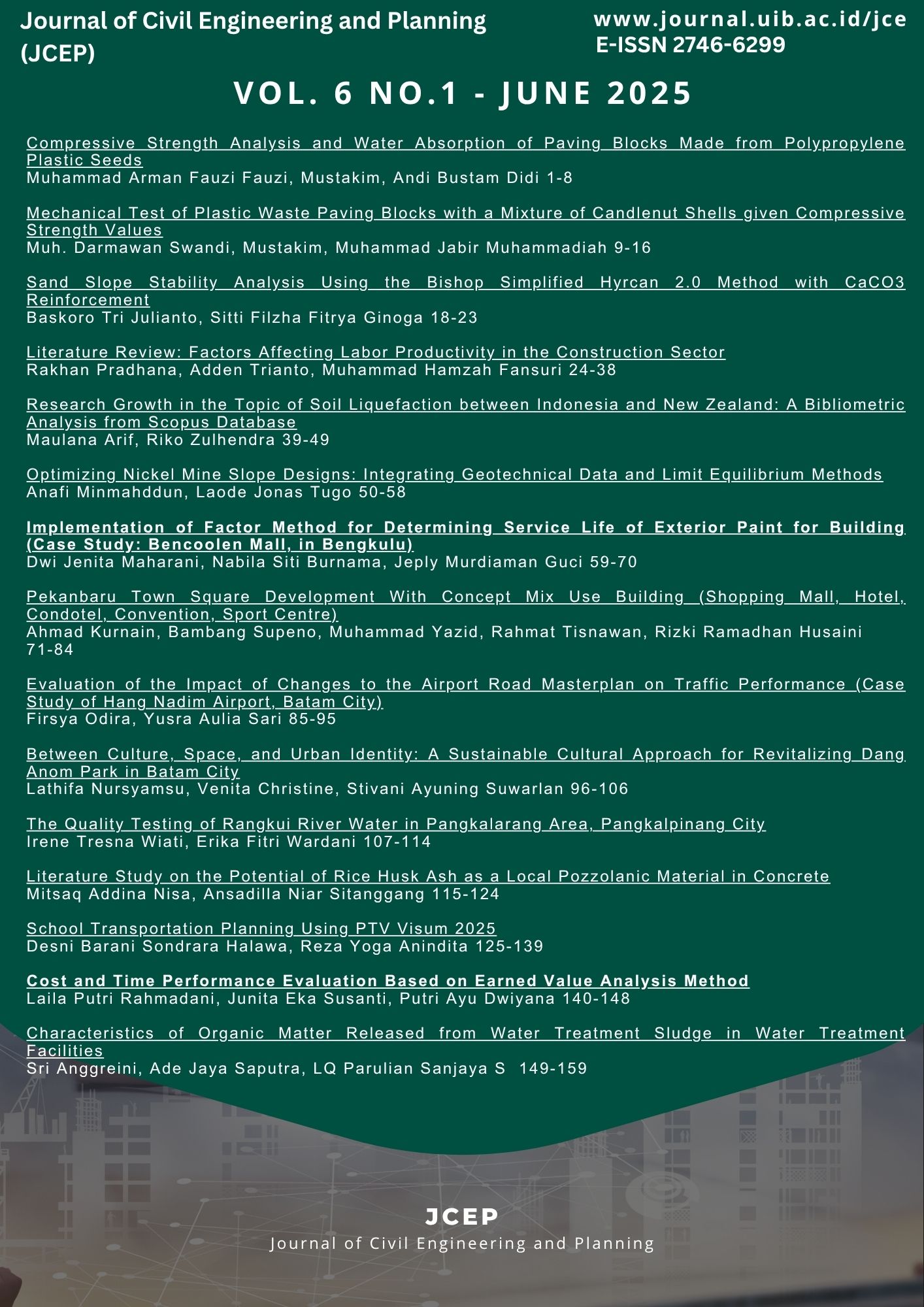Literature Study on the Potential of Rice Husk Ash as a Local Pozzolanic Material in Concrete
DOI:
https://doi.org/10.37253/jcep.v6i1.10399Keywords:
concrete, rice husk ash, pozzolan, compressive strength, durabilityAbstract
The production of cement, as the primary material in concrete manufacturing, significantly contributes to global carbon emissions. To mitigate this impact, one of the solutions being developed is the use of natural or artificial pozzolanic materials as partial substitutes for cement. Rice Husk Ash (RHA) is an agricultural waste rich in amorphous silica and holds great potential as a local pozzolanic material in Indonesia. The review results show that using RHA in the range of 10–20% can enhance the compressive strength and improve concrete resistance to aggressive environments. The effectiveness of RHA is highly influenced by the fineness of its particles and the combustion process. Considering its availability and environmental impact, RHA has great potential as an eco-friendly material solution for construction based on local resources.
Downloads
References
[1] M. Amin, “A comprehensive review on chemical, mineralogical, and morphological characteristics of supplementary cementitious materials (SCMs),” Construction and Building Materials, vol. 285, p. 122936, 2021.
[2] H. Aziz, P. Suprobo, and D. Hartono, “The role of rice husk ash in enhancing durability of concrete exposed to aggressive environment,” IOP Conference Series: Materials Science and Engineering, vol. 1243, no. 1, p. 012015, 2022.
[3] A. M. Fadhil, N. H. Ali, and I. S. Kareem, “Effects of rice husk ash on mechanical properties of concrete: A review,” Materials Today: Proceedings, vol. 42, pp. 2601–2606, 2021.
[4] S. Irawan, A. Yani, and G. Pratama, “Effect of combustion temperature on rice husk ash reactivity as pozzolanic material,” Jurnal Teknik Sipil, vol. 27, no. 1, pp. 35–42, 2020.
[5] S. Li, Z. Xu, and J. Wu, “Utilization of rice husk ash as sustainable supplementary cementitious material: Strength and durability properties,” Journal of Cleaner Production, vol. 407, p. 137198, 2023.
[6] R. Napitupulu and V. Simanjuntak, “Kajian pemanfaatan abu sekam padi sebagai substitusi semen pada beton mutu sedang,” Jurnal Teknik Sipil Universitas Sumatera Utara, vol. 12, no. 2, pp. 79–86, 2023.
[7] S. Nisar and A. H. Bhat, “Rice husk ash as a potential pozzolanic material in sustainable concrete—A review,” Environmental Technology & Innovation, vol. 24, p. 101865, 2021.
[8] V. Patel and R. Shah, “An overview of concrete composition and properties,” Materials Today: Proceedings, vol. 32, no. 1, pp. 546–551, 2020.
[9] M. A. Rahman, M. S. Islam, and M. M. Hossain, “Effect of curing conditions on the strength development of concrete incorporating RHA,” Procedia Engineering, vol. 171, pp. 760–767, 2018.
[10] D. Setiawan, A. Pramudita, and Y. Wijaya, “Optimal combustion temperature for maximizing pozzolanic reactivity of rice husk ash,” Jurnal Rekayasa Sipil dan Lingkungan, vol. 6, no. 2, pp. 101–108, 2022.
[11] J. J. Thomas and H. M. Jennings, “Supplementary cementing materials in concrete: Characterization and performance,” Cement and Concrete Research, vol. 124, p. 105810, 2019.
[12] Sari, N. L., Mustakim, & Kasmaida. "Characteristics of concrete with the addition of fabric waste as fibers on the compressive and flexural strength of concrete". Journal of Civil Engineering and Planning (JCEP), vol. 5 no.2, pp. 50–58. 2024.
[13 Jaya, D. P. Pengaruh penambahan limbah kain pakaian bekas terhadap kekuatan tekan dan bending dari komposit foam beton ringan. 2022
[14] Hariati., Astutik, Y.S. "Studi Komparatif Kerusakan Beton pada Struktur Kolom yang Keropos dengan Metode Grouting". Journal of Civil Engineering and Planning (JCEP), vol. 1 no.2, pp. 99–110. 2020.
[15] C. Li, X. Mei, D. Dias, Z. Cui, dan J. Zhou, “Compressive strength prediction of rice husk ash concrete using a hybrid artificial neural network model,” Materials, vol. 16, no. 8, pp. 3135, 2023.
[16] A. Iqtidar, N. B. Khan, S. Kashif-ur-Rehman, M. F. Javed, F. Aslam, R. Alyousef, H. Alabduljabbar, dan A. Mosavi, “Prediction of Compressive Strength of Rice Husk Ash Concrete through Different Machine Learning Processes,” Crystals, vol. 11, no. 4, pp. 352, 2021.
[17] A. L. G. Gastaldini, M. F. Javed, M. N. Sheikh, F. Aslam, dan R. Alyousef, “Erosion degradation analysis of rice husk ash-rubber-fiber concrete,” Scientific Reports, vol. 14, pp. 71939, 2024.
[18] Q. Li dan Z. Song, “Prediction of compressive strength of rice husk ash concrete based on stacking ensemble learning model,” J. Clean. Prod., vol. 382, pp. 135279, 2023.
[19] Y. Huang, Y. Lei, X. Luo, dan C. Fu, “Prediction of compressive strength of rice husk ash concrete: A comparison of different metaheuristic algorithms for optimizing support vector regression,” Case Stud. Constr. Mater., vol. 18, pp. e02201, 2023.
[20] S. I. Haruna, M. F. Javed, F. Aslam, R. Alyousef, dan M. S. Jamil, “Compressive strength of self-compacting concrete modified with rice husk ash and calcium carbide waste modeling: A feasibility of emerging emotional intelligent model (EANN) versus traditional FFNN,” Arab. J. Sci. Eng., vol. 46, no. 11, pp. 11207–11222, 2021.
[21] N. Nisar dan J. A. Bhat, “Experimental investigation of Rice Husk Ash on compressive strength, carbonation and corrosion resistance of reinforced concrete,” Aust. J. Civ. Eng., vol. 19, no. 2, pp. 155–163, 2021.
[22] W. Ma, Y. Wang, L. Huang, L. Yan, dan B. Kasal, “Natural and recycled aggregate concrete containing rice husk ash as replacement of cement: Mechanical properties, microstructure, strength model and statistical analysis,” J. Build. Eng., pp. 105917, 2023.
[23] A. S. Montoya, C. W. Chung, dan J. H. Kim, “High performance concretes with highly reactive rice husk ash and silica fume,” Materials, vol. 16, no. 11, pp. 3903, 2023.
[24] Y. Zhang, L. Wang, dan H. Li, “The Influence of Rice Husk Ash Incorporation on the Properties of Cement-Based Materials,” Materials, vol. 18, no. 2, pp. 460, 2023.
[25] M. M. Alsaed dan R. L. Al Mufti, “The Effects of Rice Husk Ash as Bio-Cementitious Material in Concrete,” Constr. Mater., vol. 4, no. 3, pp. 629–639, 2024.
[26] J. M. Marangu, M. Sharma, L. Scheinherrová, I. Kafodya, V. K. Mutai, E. Latif, V. I. Novelli, D. K. Ashish, dan R. Maddalena, “Durability of Ternary Blended Concrete Incorporating Rice Husk Ash and Calcined Clay,” Buildings, vol. 14, no. 5, pp. 1201, 2024.
[27] N. M. S. Hasan, M. H. R. Sobuz, M. M. H. Khan, N. J. Mim, M. M. Meraz, S. D. Datta, M. J. Rana, A. Saha, A. S. M. Akid, M. T. Mehedi, M. Houda, dan N. M. Sutan, “Integration of Rice Husk Ash as Supplementary Cementitious Material in the Production of Sustainable High-Strength Concrete,” Materials, vol. 15, no. 22, pp. 8171, 2022.
[28] M. Amran, R. Fediuk, G. Murali, N. Vatin, M. Karelina, T. Ozbakkaloglu, R. S. Krishna, A. K. Sahoo, S. K. Das, dan J. Mishra, “Rice Husk Ash-Based Concrete Composites: A Critical Review of Their Properties and Applications,” Crystals, vol. 11, no. 2, pp. 168, 2021.
Downloads
Published
Issue
Section
License
Copyright (c) 2025 Mitsaq Addina Nisa, Ansadilla Niar Sitanggang

This work is licensed under a Creative Commons Attribution 4.0 International License.



_0011.jpg)









